|

Just the Facts: Budgerigars (parakeets) are about 18 cm long and weigh 30-40 grams. Wild budgerigars have green under parts and rumps, while the upper parts are barred with black and yellow. The forehead and face is yellow in adults, and barred black with yellow in young till they change into their adult plumage at 3-4 months of age. Each cheek has a small dark purple patch and a series of black spots across the throat. The tail is greenish blue or purple; outside tail feathers have a central yellow band. Their wings have greenish-black flight feathers and black coverts with yellow fringes. Bill olive gray and legs grayish blue, with zygodactyl toes.
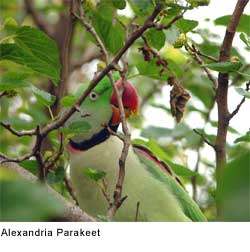 Pink and Blue: The color of the cere (the area containing the nostrils) differs between the sexes; blue in males, pink (non-breeding) or brownish (breeding) in females. Pink and Blue: The color of the cere (the area containing the nostrils) differs between the sexes; blue in males, pink (non-breeding) or brownish (breeding) in females.
Color Mutants:
Budgerigars (parakeets) are available in many different colors. Some color mutants, such as yellow (lutino) and blue, are determined by a single gene and have arisen spontaneously. Combining mutations can result in new colors (lutino and blue results
in albino) as well as new breeds.
Other color variants are the result of selective breeding resulting in more complex patterns. Using the cere to determine the gender of birds with certain color mutations such as albinos or lutinos is less reliable; these birds have ceres that can look pinkish or have a purple tinge.

Nomads of the Scrubland: Budgerigars (parakeets) are nomadic birds found in open habitats, primarily in Australian scrubland, open woodland and grassland. The birds are normally found in small flocks, but can form very large flocks under favorable conditions. The species is extremely nomadic and the movement of the flocks is tied to the availability of food and water. Drought can drive flocks into more wooded habitat or coastal areas. They feed on the seeds of spinifex, grass weeds, and sometimes ripening wheat. Both male and female budgerigars sing and can learn to mimic sounds, although both singing and mimicry are more pronounced in males.
Budgerigars as pets:
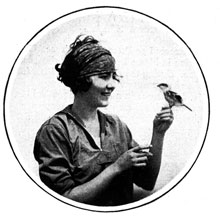 Bred for Beauty: The budgerigar is one of the few parrots to be domesticated as a pet. Believed to be the most common pet parrot in the world, it has been bred in captivity since the 1850s. Breeders have worked over the decades to produce a wide range of color and feather mutations, such as yellow, blue, white, violet, olive, albino and lutino (yellow), clearwing and spangled. Feather mutations can produce crests or overly long shaggy feathers known as "feather dusters". Bred for Beauty: The budgerigar is one of the few parrots to be domesticated as a pet. Believed to be the most common pet parrot in the world, it has been bred in captivity since the 1850s. Breeders have worked over the decades to produce a wide range of color and feather mutations, such as yellow, blue, white, violet, olive, albino and lutino (yellow), clearwing and spangled. Feather mutations can produce crests or overly long shaggy feathers known as "feather dusters".
Best in Show: Modern show budgerigars, also called English budgerigars, are larger than their wild cousins, with puffy head feathers, giving them an exaggerated look. The eyes and beak can be almost totally obscured by feathers. Such birds are reported to be more prone to genetic mutations because of inbreeding. Most budgerigars in the pet trade are not of the show variety and are similar in size and body conformation to wild budgerigars.
Teacher's Pet: Budgerigars can be taught to speak, whistle tunes, and play with humans. They are intelligent and social animals and enjoy the stimulation of toys and interaction with humans as well as with other budgerigars. A common behavior is the chewing of material such as wood, especially for female budgerigars.
Long Live the Parakeet! In captivity, budgerigars live an average of five to eight years, but are reported to occasionally live to 15 if well cared for. The life span depends on the budgerigar's breed (show budgerigars typically do not live as long as the common budgerigars) and the individual bird's health, which is influenced by exercise and diet.
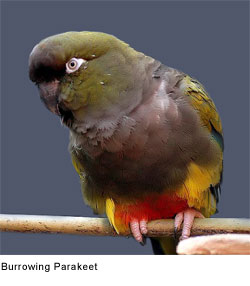 Feed Your 'Keet: Although wild budgerigars eat grass seeds almost exclusively, avian veterinarians recommend supplementation with foods such as fresh fruits and vegetables, sprouted seeds, pasta, whole wheat bread and other healthy human foods, as well as pellets formulated for small parrots. Adding these foods provides additional nutrients and can prevent obesity and lipomas, as can substituting millet, which is relatively low in fat, for Feed Your 'Keet: Although wild budgerigars eat grass seeds almost exclusively, avian veterinarians recommend supplementation with foods such as fresh fruits and vegetables, sprouted seeds, pasta, whole wheat bread and other healthy human foods, as well as pellets formulated for small parrots. Adding these foods provides additional nutrients and can prevent obesity and lipomas, as can substituting millet, which is relatively low in fat, for
seeds mixes.
Budgerigars do not always adapt readily to dietary additions, however. Chocolate and avocado are recognized as potential toxins. Plums, lemons, limes, and members of the cabbage family are bad for them as well. Recommended fruits and vegetables are apples, oranges, bananas, strawberries, carrots, unsprayed lettuces, parsley, and spinach.
Public Speakers: In 2001, budgie owner Ryan B. Reynolds of Ontario, Canada received much publicity due to his release to the press of certain recordings of his talking budgie, Victor. In these recordings, Victor performed what appeared to be "speaking in context". To the layperson, the recordings appeared to audibly demonstrate that Victor was able to use his 1000+ word vocabulary to express coherent lines of thought, meaning and reasoning. Despite the widespread TV, newspaper and radio publicity the recordings received in 2001, the recordings have yet to be scientifically analyzed, proven, (or disproved).
--------------------------------------------------------------------------------------------------------------------------
A Tale of Two Species: Carolina Parakeet & Monk Parakeet
Life and Death of the Carolina Parakeet: The Carolina Parakeet (Conuropsis carolinensis) was the only parrot species native to the eastern United States. It was found from the Ohio Valley to the Gulf of Mexico, and lived in old forests along rivers. It was the only extinct species at the time classified in genus Conuropsis.
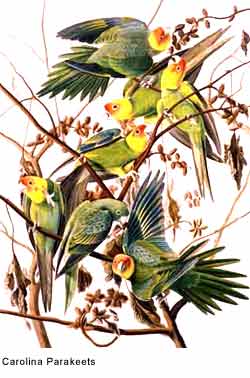 Pets or Pests? The Carolina Parakeet died out because of a number of different threats. To make space for more agricultural land, Pets or Pests? The Carolina Parakeet died out because of a number of different threats. To make space for more agricultural land,
large areas of forest were cut down, taking away its living space. The colorful feathers (green body, yellow head, and red around the bill) were in demand as decorations in ladies' hats, and the birds were kept as pets.
Even though the birds bred easily in captivity, little was done by owners to increase the population of tamed birds. Finally, they were killed in large numbers because farmers considered them a pest, although many
farmers valued them for controlling invasive cockleburs.
Unfortunate Flocking: A factor that contributed to their extinction was
the unfortunate flocking behavior that led them to return immediately to a location where some of the birds had just been killed. This led to even more being shot by hunters as they gathered about the wounded and dead members of the flock.
The Last American Parakeet: The last wild specimen was killed in Okeechobee County in Florida in 1904, and the last captive bird died at the Cincinnati Zoo in 1918. This was the male specimen "Incas," who died within a year of his mate "Lady Jane."
The Monk Parakeet Lives On: The Monk Parakeet (Myiopsitta monachus), also known as the Quaker Parrot, is a species of parrot that originated in the temperate areas of Argentina and Brazil in South America. It is the only member of the genus Myiopsitta.
Just the Facts: This parrot is, on average, 29 cm long with a 48 cm wingspan, and weighs 100 g. Females tend to be 10-20% smaller. It has bright green upperparts. The forehead and breast are pale grey and the rest of the underparts are very-light green to yellow. The flight feathers are dark blue, and the tail is long and tapering. The bill is orange. The call is a loud and throaty graaa or skveet. Domestic breeds have produced colors other than the natural plumage; these include white and blue in place of green.
Nest and Nestlings: The Monk Parakeet is the only parrot that builds a stick nest, in a tree or on a man-made structure, rather than using a hole. This gregarious species often breeds colonially, building a single large nest 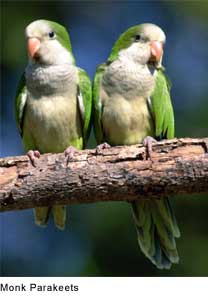 with separate entrances for each pair. In the wild, the colonies can become quite large, with pairs occupying separate "apartments" in nests that can reach the size of a small automobile. Their 5-12 eggs hatch in about 24 days. with separate entrances for each pair. In the wild, the colonies can become quite large, with pairs occupying separate "apartments" in nests that can reach the size of a small automobile. Their 5-12 eggs hatch in about 24 days.
Help from Friends: Unusually for a parrot, Monk Parakeet pairs occasionally have helper individuals, often a grown offspring, which assists with feeding the young.
Brilliant Birds! Monk Parakeets are highly intelligent, social birds. Those kept as pets routinely develop large vocabularies, and are thought to be second only to the African Grey Parrot in verbal skills.
Monks Abound! The Monk Parakeet was brought to the United States in the late 1960s as a pet. Many escaped or were intentionally released, and populations were allowed to proliferate. By the early 1970s, it was established in seven states, and by 1995 it had spread to eight more. There are now thought to be approximately 100,000 in Florida alone.
Problems with introduced populations: In Argentina and Uruguay, Monk Parakeets are regarded as major agricultural pests (as Charles Darwin noted). In areas where they have been introduced, some fear that they will harm crops and native species. Evidence of the harm of these birds in introduced areas is disputed, and many people oppose killing a charismatic bird, but there have been local bans and eradication programs in some areas of the USA. Due to its invasive species status, a number of states outlaw either importation, sale, release, or mere possession of a
monk parakeet.
Outside the USA, introduced populations do not appear to raise similar controversy, presumably because of smaller numbers of birds.

Romance in the Rain: Breeding takes generally place between June and September in the North and between August and January in the South but they are opportunistic breeders responding to the rains when grass seeds become most abundant. Populations in some areas have increased as a result of increased water availability
at farms.
Nest and Nestlings: The nest is in a hole in a tree, fence post or even a log laying on the ground; the 4-6 eggs are incubated for 17-19 days, with the young fledging about 30 days after hatching.

Though budgerigars are often called parakeets, especially in American English, this term also refers to any of a number of small parrots with long flat tails.
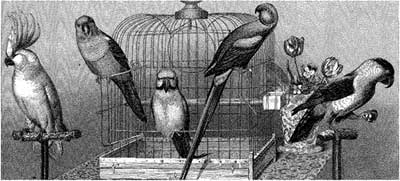
All text is available under the terms
of the GNU Free Documentation License
|